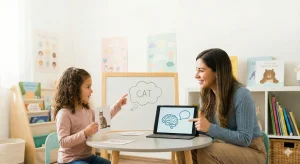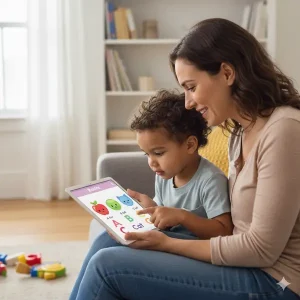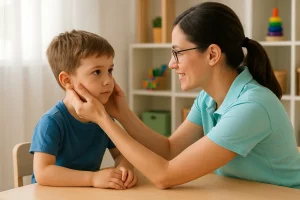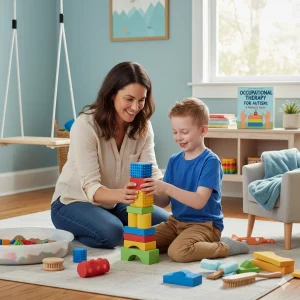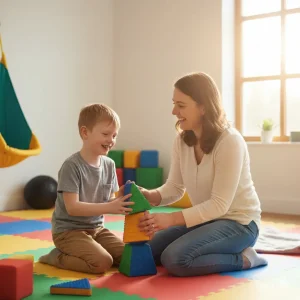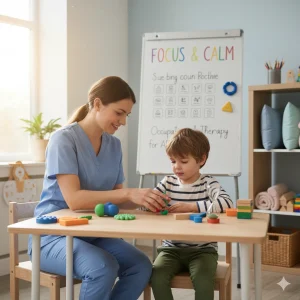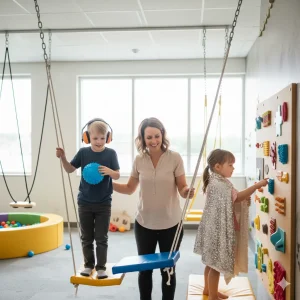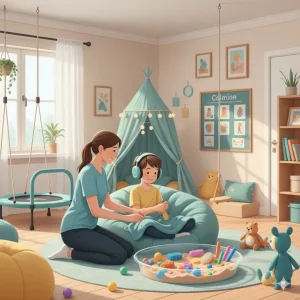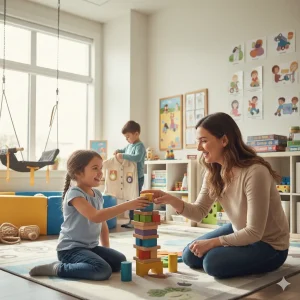Occupational Therapy for 9-Year-Olds: Focus & Confidence
By Wellness Hub
Last Updated: October 21, 2025
Ever wondered why your 9-year-old still struggles to write neatly, focus in class, or keep up with daily routines — even though they’re bright and eager to learn? You’re not alone. Many parents notice these challenges around this age, when schoolwork, coordination, and independence demands start to rise. That’s where occupational therapy for 9-year-olds makes a real difference. It helps children build the confidence, attention, and coordination they need to thrive — both in school and at home. Through playful, goal-based activities, occupational therapists strengthen fine-motor skills, boost focus, and teach practical self-help habits that make everyday tasks easier.
What Is Pediatric Occupational Therapy for a 9-Year-Old?
By age nine, many children are juggling schoolwork, handwriting, sports, and growing independence. But when everyday tasks like writing neatly, organizing materials, or paying attention feel harder than they should, pediatric occupational therapy (OT) steps in to help.
Occupational therapy for kids focuses on building the practical skills children need for daily life — from handwriting and dressing to focusing in class and joining play activities with confidence. For school-age children, OT bridges the gap between ability and participation. It’s not just about therapy sessions; it’s about helping your child succeed in real-world settings like classrooms, playgrounds, and home routines.
At age nine, children enter a critical stage of skills integration, where coordination, fine-motor control, and executive function must come together. An occupational therapist evaluates your child’s strengths and challenges, then designs fun, goal-based activities that develop independence, focus, and self-esteem.
Collaboration plays a big role too — therapists often work closely with parents and teachers to create consistent strategies across school and home. This teamwork ensures your child gets the right support in both environments, whether it’s a new pencil grip for better handwriting or a calming routine for sensory regulation.
Parent Tip: Think of OT as your child’s personal roadmap to everyday success. Even small changes — like structured routines or hand-strength games — can make a big difference in their confidence and performance.
How OT Differs from PT, Speech, and Psychology
Parents often wonder how occupational therapy (OT) compares with physical therapy (PT), speech therapy (SLP), or psychology. Each service supports children in unique ways — but they often work together to help your child reach their full potential.
| Therapy Type | Focus Area | Typical Goals | Setting | Referral Reasons |
|---|---|---|---|---|
| Occupational Therapy (OT) | Fine motor, sensory, coordination, daily living | Handwriting, self-care, focus, sensory regulation | School, clinic, home | Difficulty with handwriting, attention, organization |
| Physical Therapy (PT) | Gross motor strength, posture, movement | Balance, walking, endurance | Clinic, school | Poor balance, low muscle tone, coordination issues |
| Speech Therapy (SLP) | Communication and oral motor skills | Speech clarity, language, feeding | School, clinic | Speech delay, articulation, language comprehension |
| Psychology/Counseling | Emotional and behavioral health | Coping skills, anxiety, social behavior | Clinic, school | Anxiety, low motivation, emotional regulation |
While PT targets movement, and speech therapy focuses on communication, OT brings it all together — helping children apply their motor, sensory, and thinking skills to daily life. A child may work with all three professionals as part of a holistic plan.
Therapist Insight: OT often becomes the “bridge” between physical abilities and real-world participation. For example, PT may improve leg strength, but OT ensures your child can climb stairs with confidence, carry their school bag, and manage transitions independently.
Signs Your 9-Year-Old Might Benefit from Occupational Therapy
Every child develops at their own pace — but when daily routines or school tasks feel harder than they should, it may be time to look a little closer. Occupational therapy (OT) helps children who struggle with everyday skills like handwriting, coordination, attention, or self-care. Spotting these early signs your child needs OT can make a huge difference in building their confidence and success.
Here are some common red flags parents notice around age nine:
- Handwriting difficulties: Your child writes slowly, presses too hard, or avoids writing tasks altogether. Letters may be uneven, spaced irregularly, or cause hand pain after a short time.
- Coordination challenges: They struggle with ball games, catching or throwing accurately, using scissors, tying shoelaces, or handling utensils during meals.
- Visual-motor problems: Copying from the board is tough, math columns don’t line up, or written work looks disorganized even when your child understands the concept.
- Sensory sensitivities: They get overwhelmed by loud noises, crowded classrooms, or certain clothing textures. Some kids avoid messy play like paint, glue, or sand.
- Self-care struggles: Buttons, zippers, hair grooming, or keeping the school bag tidy are daily battles, often leading to frustration or delays.
- Executive function and attention: They have trouble planning tasks, following multi-step directions, managing time, or completing homework without constant reminders.
While some of these difficulties can appear mild or occasional, consistent patterns across home and school often signal that extra support could help. OTs use play-based strategies to strengthen fine motor, sensory, and attention skills — helping your child feel more capable and calm in everyday life.
Parent Tip: If teachers mention handwriting, attention, or self-organization concerns, don’t panic — but don’t ignore them either. Early OT intervention can prevent small frustrations from turning into learning barriers.
What Occupational Therapy Works On at Age 9
At around age nine, children are refining the complex skills they’ve built through early childhood — writing longer sentences, managing school materials, and sitting through longer lessons. When any of these feel harder than expected, occupational therapy (OT) focuses on strengthening the underlying abilities that support learning, attention, and independence. Each session targets specific developmental areas that help children function better at home and in school.
Here are the core areas occupational therapy works on for 9-year-olds:
- Fine Motor Skills & Hand Strength: These are the small muscle movements that help children hold a pencil correctly, cut with scissors, and manipulate small objects. OTs use playful exercises like clothespin games, putty pulls, and bead threading to improve pencil grasp, dexterity, and control.
- Visual-Motor Integration & Perception: This involves connecting what the eyes see with how the hands move — essential for neat handwriting, copying from the board, and organizing written work. OT activities like mazes, tracing patterns, and puzzles build accuracy and spacing awareness.
- Posture & Core Strength: A strong core helps children sit upright, focus, and write without tiring easily. Therapists include animal walks, wall push-ups, and balance games to improve shoulder stability and trunk endurance needed for long desk tasks.
- Bilateral Coordination: This skill means using both sides of the body together — like stabilizing paper with one hand while writing with the other, or cutting and pasting crafts. OT sessions often include catching games, rope skipping, or two-hand tasks to strengthen coordination.
- Sensory Processing & Self-Regulation: Children who are easily distracted, anxious, or overstimulated benefit from calming or alerting sensory activities. OTs create individualized “sensory diets” using movement breaks, deep pressure, or fidget tools to improve focus and emotional control.
- Executive Function: These are the brain’s planning and organizing skills — setting goals, starting tasks, and staying on track. OT helps children use visual checklists, color coding, and “plan-do-review” routines to become more independent with homework and time management.
Each of these areas supports the others. Stronger posture leads to better writing endurance, while improved self-regulation helps a child stay focused long enough to complete a task. Over time, these building blocks help children feel capable, confident, and more engaged in learning.
Parent Tip: Notice where your child tires or avoids certain tasks — that’s often where the biggest therapy wins happen. Small, consistent improvements here lead to big confidence boosts later.
Classroom Outcomes to Expect
Parents often ask, “When will I see a difference?” The good news is, occupational therapy progress often shows up right in the classroom — not just in test results, but in daily routines and behavior.
Here’s what you might notice as therapy takes effect:
- Improved handwriting — neater, faster, and more consistent letter spacing.
- Better attention and task completion — fewer reminders to stay on task.
- More independence — managing books, bag, and homework with less help.
- Improved posture and endurance — sitting upright through class comfortably.
- Increased participation — confidence in games, PE, and group activities.
These changes happen gradually but steadily as your child’s skills strengthen. When classroom teachers start saying, “They’re more focused and organized lately,” that’s when you know OT is making a real-world impact.
Know more: How Occupational Therapy Helps 10-Year-Olds Excel in School
How an Occupational Therapy Plan Is Built: Assess → Plan → Practice
Every effective occupational therapy (OT) journey begins with understanding your child as a whole — their strengths, challenges, and unique learning style. For parents, knowing how an OT plan is built helps you see the structure and science behind every session. The process is collaborative and transparent, ensuring your child’s therapy directly supports real-life goals at home and in school.
Here’s a simple breakdown of the four key steps in an OT plan:
Assessment (Discovering the “Why”)
The first step is a thorough OT evaluation that includes conversations with parents and teachers, classroom observations, and standardized tests such as the Beery VMI (for visual-motor integration), BOT-2 (for coordination), and Sensory Profile or SPM (for sensory processing). This step helps identify what’s making tasks like handwriting, attention, or coordination difficult for your 9-year-old.
Goal Setting (Defining the “What”)
Once the root challenges are clear, the therapist sets SMART goals — Specific, Measurable, Achievable, Relevant, and Time-bound. Each goal ties back to a meaningful school or home activity, such as “write a full paragraph legibly within 10 minutes” or “organize homework materials independently.” These goals guide every therapy decision that follows.
Intervention (Practicing the “How”)
This is where therapy comes alive. Sessions use graded activities — tasks that start simple and become more complex as your child gains skill. Strategies may include fine-motor games, sensory regulation exercises, and classroom accommodations (like pencil grips or movement breaks). Therapists also share home programs so parents can support progress through short, daily routines.
Review (Measuring the “Progress”)
Regular data tracking and progress notes ensure therapy stays goal-oriented. OTs use checklists, timed trials, and visual samples to measure improvement. Every few months, goals are re-assessed and adjusted — a process that keeps therapy dynamic and results-focused.
Session: What a 45–60 Minute OT Session Looks Like
Curious what happens during an occupational therapy session? Here’s a realistic snapshot of what a typical OT session for a 9-year-old might include. Every minute is designed to balance structure, fun, and function.
Warm-Up (5–10 minutes) – Sensory or movement-based activities help your child’s body and brain get ready to focus. Examples: obstacle courses, scooter board rides, or animal walks.
- Core Activity (20–25 minutes) – Targeted practice on specific skills like handwriting, cutting, or fine-motor games. The therapist adjusts the challenge level so your child feels successful while still improving coordination and endurance.
- Regulation Break (5 minutes) – A quick calming or alerting task like deep breathing, wall pushes, or weighted ball tosses to reset focus.
- Functional Task Practice (15–20 minutes) – Applying new skills in real-life ways: writing a paragraph, buttoning clothes, or packing a school bag. This bridges therapy with daily life.
- Cool-Down & Parent Notes (5 minutes) – Gentle stretches or a quiet game close the session, followed by a short update for parents on what worked and what to reinforce at home.
- Each session builds consistency — children learn not just to perform tasks, but to enjoy doing them. Over time, this structured approach strengthens confidence, focus, and independence.
Therapist Insight: A good OT session feels like play but is grounded in evidence-based goals. Every activity is intentional — building neural connections for smoother, more coordinated movement and clearer attention.
At-Home Occupational Therapy Strategies for Parents (10-Minute Wins)
You don’t need fancy equipment or long sessions to help your child build better coordination, attention, and motor control. In fact, small, consistent practice at home — even just 10 minutes a day — can make a big difference. These simple home OT activities blend play with purpose, giving parents easy ways to support therapy goals between sessions.
Here are some fun and effective “10-minute wins” you can try at home:
- Hand Strength: Encourage strong, steady hands with playful activities like clothespin races or a therapy putty treasure hunt. Ask your child to pinch, squeeze, and dig to find hidden beads or coins. These build endurance for writing and fine-motor control.
- Visual-Motor Skills: Practice eye-hand coordination with dot-to-dot puzzles, tangrams, or simple origami. These boost focus, spatial awareness, and accuracy — key for copying from the board and organizing written work.
- Posture & Core Strength: Support your child’s writing stamina by improving trunk stability. Try wall push-ups, animal walks, or scooter board play if available. A stronger core means less fidgeting and better sitting posture during homework or reading.
- Bilateral Coordination: Use both hands together in fun crafts — folding paper, cutting shapes, or making collages. Activities like jump rope or catch-and-pass ball games also help both sides of the body work in sync.
- Self-Regulation: Build calm and focus with sensory mini-breaks. Teach your child a 5-breath box breathing exercise or schedule movement breaks every 20 minutes during homework. These reset attention and reduce frustration.
- Executive Function: Help your child plan and stay organized with a visual “Plan–Do–Review” chart. Add a backpack checklist with steps like “Homework folder → Water bottle → Lunch box.” Visual routines turn chaotic mornings into smoother starts.
Even a few of these activities sprinkled through the week can boost handwriting control, attention, and confidence — all while feeling like play.
Parent Tip: Choose one or two strategies at a time, keep them fun, and celebrate small improvements. Kids stay more motivated when success feels easy and rewarding.
Read more: Is Your 1-Year-Old Delayed? Occupational Therapy for 1-Year-Old
Screen Time, Posture, and Ergonomics: Setting Up for Success
Today’s children spend hours at screens and study desks — often in postures that strain their growing bodies. Good ergonomics are key to healthy posture, better handwriting, and fewer aches during long study sessions.
Here’s a quick checklist to keep your child’s workspace OT-approved:
- Chair height: Hips, knees, and ankles should all be at 90°. Feet must rest flat on the floor or a sturdy footrest.
- Desk height: Elbows should rest comfortably at table level, not too high or low.
- Writing support: Use a slanted board or clipboard for better wrist alignment and reduce fatigue.
- Lighting: Ensure the workspace is bright, with minimal glare. Natural light is best for eye comfort.
- Screen position: Keep the top of the screen at eye level. Follow the 20–20–20 rule — every 20 minutes, look 20 feet away for 20 seconds.
- Screen-time limits: Follow WHO and APA guidelines — less than 2 hours of recreational screen time per day for school-age kids. Encourage outdoor play and movement breaks to offset sitting time.
- Writing tools: Choose ergonomic pencils or triangular grips to improve hand comfort and control.
Good posture supports not just physical comfort but also better attention and stamina for schoolwork. Pairing healthy ergonomics with short sensory or movement breaks can prevent fatigue and help your child focus longer.
Therapist Insight: The right chair height or pencil grip might seem minor, but these small adjustments often bring major improvements in handwriting speed and endurance.
Also read: OT for 5-Year-Olds: Writing & Dressing Made Easy with Early Support
When to Seek an Occupational Therapy (OT) Evaluation — A Parent’s Decision Guide
Every child learns and develops at their own pace, but sometimes small struggles become patterns that start to affect confidence, learning, or daily routines. If you’ve ever wondered, “Does my child need OT?” — this simple guide can help you decide when it’s time to take the next step.
Occupational therapy focuses on helping children master everyday skills — from handwriting and attention to coordination and emotional regulation. Knowing when to see an OT ensures your child gets support early, before frustration or avoidance sets in.
Here’s a quick decision checklist for parents:
- Persistent Challenges: If a difficulty — such as poor handwriting, slow dressing, or clumsiness — lasts for more than 3 months despite regular practice, it’s time to explore an OT evaluation.
- School Impact: When struggles begin to affect classroom performance, attention, or self-esteem — for example, refusing to write or avoiding PE — an OT can identify the root cause and create practical solutions.
- Daily Life Frustrations: Notice if routines like eating, brushing, organizing, or focusing on homework are consistently stressful. These are signs your child’s motor or sensory systems might need extra support.
- Teacher or Caregiver Concerns: Teachers often spot functional challenges early — poor pencil control, low attention span, or difficulty following multi-step directions. Their feedback is valuable in identifying OT needs.
- Coexisting Conditions: If your child has been diagnosed with or shows traits of ADHD, Developmental Coordination Disorder (DCD), or Autism Spectrum Disorder (ASD), an OT can be part of a multidisciplinary support plan to build independence and coping skills.
- Pediatrician Referral: Many families start with a pediatric referral when they notice these concerns. Your doctor may recommend a developmental screening and connect you with a licensed pediatric OT.
A helpful way to think about it:
“If a skill gap causes stress at home, struggle at school, or frustration for your child — it’s worth an OT check.”
You don’t have to wait for major delays to act. Early evaluation can uncover subtle motor or sensory differences and provide a clear plan for improvement. Most OTs use engaging, play-based assessments that children actually enjoy, making the process both informative and stress-free.
Parent Tip: Trust your instincts. You know your child best — and seeking an OT evaluation doesn’t mean something is wrong; it’s a proactive step toward helping them feel capable, confident, and ready to thrive.
Conclusion
If your 9-year-old struggles with handwriting, attention, or coordination, early occupational therapy can help them grow with confidence. OT teaches practical skills that make daily tasks easier and school life smoother. With teamwork between parents, teachers, and therapists, small wins turn into big progress. Each session helps your child focus better, stay organized, and feel proud of their abilities. Don’t wait—trust your instincts and seek help early. A little support now can build stronger skills, happier routines, and a confident, independent future for your child. Early help truly creates lasting change.
Frequently Asked Questions:
1. What skills can occupational therapy improve for 9-year-olds?
Occupational therapy helps children strengthen fine motor skills, hand-eye coordination, focus, and daily routines. It supports tasks like handwriting, tying shoelaces, buttoning clothes, and organizing schoolwork. OT makes these everyday skills easier and builds confidence through fun, goal-based activities.
2. How is occupational therapy different from tutoring or extra classes?
Tutoring focuses on academics, while occupational therapy improves the foundation skills needed for learning — like focus, posture, handwriting, and coordination. OT helps children use their bodies and minds more efficiently so studying and writing become easier.
3. Can occupational therapy help my child with poor handwriting?
Yes. OTs work on handwriting improvement through exercises that strengthen hand muscles, teach proper pencil grip, and improve visual-motor control. Over time, children write faster, neater, and with less fatigue.
4. Is occupational therapy helpful for children with sensory issues?
Absolutely. Many 9-year-olds who are sensitive to sounds, textures, or lights benefit from sensory-based OT. Therapists use calming or alerting activities to help children stay focused, handle noisy classrooms, and feel more comfortable in daily routines.
5. What should I expect in the first few OT sessions?
The first sessions usually include fun activities like obstacle courses, puzzles, and fine-motor games. Your OT will observe how your child moves, focuses, and follows directions. Each session builds toward specific goals like better coordination or self-control.
6. How often should my child attend OT sessions?
Most children start with 1–2 sessions per week, depending on their needs. Consistency matters more than frequency — even short home practice between sessions helps progress faster.
7. Can occupational therapy help with focus and homework time?
Yes. OTs teach children self-regulation and focus strategies such as movement breaks, visual schedules, and organization routines. These techniques help your child manage attention, reduce distractions, and finish homework more calmly.
8. What can I do at home to support my child’s OT goals?
Practice short, playful activities daily — like clothespin games for hand strength, dot-to-dot puzzles, or wall push-ups. Use a visual checklist for routines and keep homework sessions short with movement breaks in between.
9. How do I explain OT to my child?
Tell your child that occupational therapy is “special playtime that helps your body and brain work together.” Framing OT as fun and helpful reduces anxiety and builds motivation to try new challenges.
10. How long does occupational therapy usually last?
It varies for each child. Some see progress within 2–3 months, while others need ongoing support. The OT will review goals every few weeks and adjust the plan as your child grows stronger and more independent
About Author:
Sonali Sharma, Occupational Therapist
Sonali Sharma is a skilled Occupational Therapist at Wellness Hub, with over three years of experience in supporting children with developmental, behavioral, and learning challenges. She holds a Bachelor’s in Occupational Therapy (BOT) from Amity University and has worked with leading institutions such as NIMHANS Bengaluru and ESIC Hospital Faridabad.
At Wellness Hub, Sonali provides online occupational therapy sessions tailored to each child’s needs. She specializes in pediatric therapy, autism support, sensory integration, and developmental skill-building, helping children strengthen motor skills, improve focus, and become more independent in daily life.
Her therapy style is child-centered, play-based, and evidence-driven—making sessions both effective and enjoyable for kids. Sonali also equips parents with practical home therapy strategies to extend progress beyond sessions.
Passionate about empowering families, Sonali believes in creating a nurturing space where children can thrive while parents feel supported every step of the way.
Book your Free Consultation Today
Parent/Caregiver Info:
Client’s Details:
* Error Message
